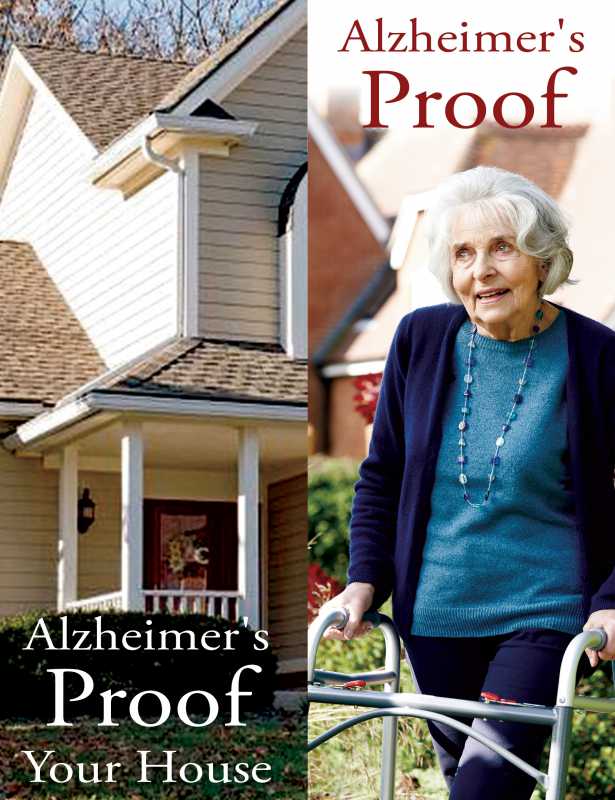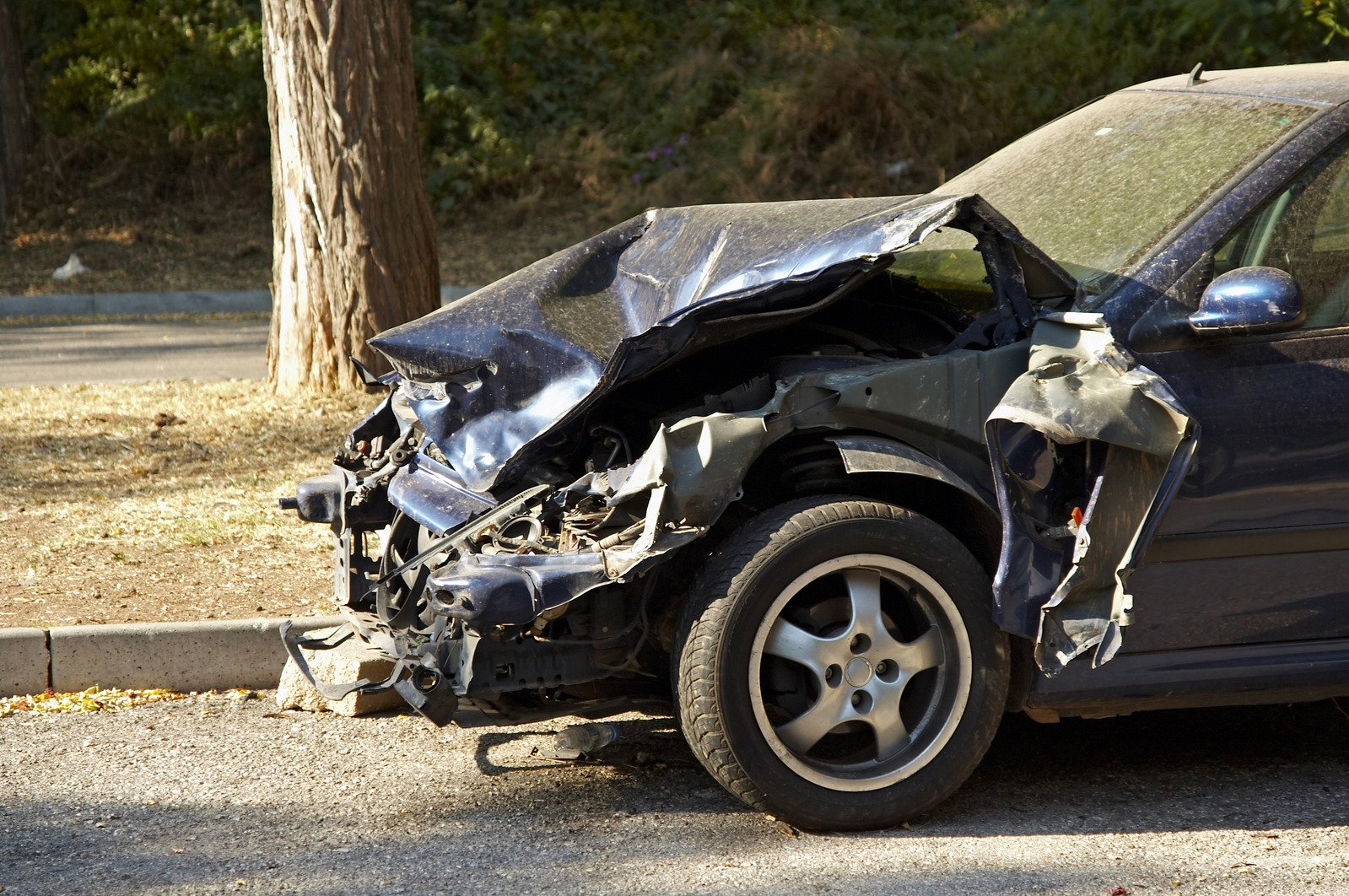Ultimate Guide to Alzheimer’s-Proofing A Home
Part One: The Master List
Five-Part Complete Guide to Alzheimer’s Proofing Your House
Part 1 | Part 2 | Part 3 | Part 4 | Part 5
Introductory Comments
As readers of this blog may already know, it fell to me to care for my dad, Jim, when he developed Alzheimer’s dementia. (Read “Jim’s Story.”) Among all the many challenges that I had to face initially was that of trying to make the home environment safe for Jim’s care.
As I told numerous individuals, if you are going to care for your loved one at home – whether your home or theirs – then you must treat the living space as a care environment. For some families, this might mean that the residence begins to look more like a hospital, complete with hospital beds, oxygen equipment, intravenous fluid-delivery systems, and so on. For others, however, the house will take on characteristics more reminiscent of a retirement community or a nursing home.
Whatever the look or “feel” of the home, the main idea is that it is up to the caretaker to adjust, alter or otherwise modify the living environment to maximize the ability to care for the loved one and keep him or her safe. In a word, you have to AlzheimersProof your living space. (“What Do We Mean By ‘Alzheimer’s Proofing’?”) In some respects, it is similar to babyproofing or childproofing a home. But in other respects, it differs notably.
The following is a work in progress. But it constitutes a sort of “master list” for home modifications that may be necessary or suitable for those suffering from dementia. Your feedback and suggestions are welcomed. As with many of my other posts, simply put, this is the list that I wish I had had at my disposal when I had to undertake the challenge of AlzheimersProofing my dad’s house.
The Usual Disclaimers
I am neither a lawyer nor a doctor. And I am not a home-improvement specialist or contractor. My articles are based on my own personal experience and research and they are provided on an as-is basis for informational purposes only. Not all listed or suggested modifications may be necessary in every situation. Contrariwise, some modifications may be necessary for you that are not listed.
Every situation is different. Readers are invited to create their own, personalized lists gleaning ideas from the master list and mixing in observations of their own. It is advisable, then, that readers carefully survey their area and walk through their (or their loved one’s) home environment, looking for and noting those items that might be hazardous. If you have background childproofing a house, then you have a bit of a head start (as some modifications translate easily from one application to the other).
Additionally, I make no promises about the feasibility of performing the needed modifications. To put it differently, not everyone is capable of executing the contemplated modifications on a do-it-yourself basis. You may want to seek profession advice or professional installation. When in doubt, consult an expert near you.
Also, keep in mind that no amount of modifications can or should replace caretaker diligence. Never leave a cognitively impaired person alone. Obviously, this is more important the more severe the impairment. And, since dementias are progressive diseases, the expectation is that your oversight will have to increase as your loved one’s condition worsens.
Some areas of the home – for example, the bathroom, garage, and kitchen – are especially dangerous (see below for safety tips). But, in truth, every room has its own dangers and risks.
Try to AlzheimersProof in as thorough a way as you can, given your energy, money, time, and other resources. The idea is to make a good-faith effort to protect your loved one. Try to anticipate or foresee your loved one’s needs and to meet them proactively. For example, if you are trying to prevent dad’s or grandma’s late-night kitchen raid, you might consider putting a judiciously stocked minifridge in his or her bedroom.
As difficult as the prospect might, though, you should be ready to entertain the possibility that the home may be unsuitable for your loved one’s care. I cannot give personalized advice. This website is merely for informational purposes. However, you should consult with attorneys, doctors, family members, financial planners, and others who can help you make the best decisions possible and to plan well for your loved one’s care.
Be safe and good luck to you and your family!
Master List
How to Use the Master List
The master list is an alphabetized directory of things that may need attention in or around the home.
You might find that simply reading the name of the item sparks your own ideas about how to sufficiently modify, protect, remove, secure, or otherwise “deal with” the item in question.
If not, then you can locate the follow-up, companion articles (as they are written!) to obtain more details and tips for the relevant action steps or items.
Click the bracketed links for more details on the selected entry.
Alcohol. Remove or restrict access to. [Specific Tips for middle-stage Alzheimer’s]
Answering machines. Use for call-screening purposes. [Specific Tips for middle-stage Alzheimer’s]
Appliances, electrical. Keep away from water. [Kitchens and Bathrooms]
Assist bars. Add next to bed. [Indoors and Outdoors]
Attic fans. See Fans. [Indoors and Outdoors]
Baby monitors. Use for monitoring patients. [Indoors and Outdoors]
Batteries. Store and discard batteries correctly. [General- and Senior-Safety Tips]
BBQ equipment. Remove or restrict access to. [Indoors and Outdoors]
Bed monitors. Use to alert to falls or movement. [Indoors and Outdoors]
Bed rails. Use to prevent falls. [Indoors and Outdoors]
Benches. Place in entryway to help with carrying packages. [General- and Senior-Safety Tips]
Bicycles. Secure. [Indoors and Outdoors]
Bleach. Restrict access to. [Indoors and Outdoors]
Blenders. See Appliances, electrical. [Kitchens and Bathrooms]
Bookshelves. Anchor. [Indoors and Outdoors]
Break-in Deterrence. Cut back bushes, foliage, and shrubbery; install motion-sensing lighting. [General- and Senior-Safety Tips]
Burners. See Stovetop. [Kitchens and Bathrooms]
Cabinets. Install “childproof” locks on. [Kitchens and Bathrooms]
Camouflage. Use to distract from door knobs and danger areas. See also Triggers. [Specific Tips for middle-stage Alzheimer’s]
Centerpieces. See Table centerpieces. [Kitchens and Bathrooms]
Chair lifts. Install as needed, if affordable. [Indoors and Outdoors]
Chemicals, flammable. Store correctly; restrict access to. [General- and Senior-Safety Tips]
Cigarettes, cigars, etc. Remove; control; monitor. [Specific Tips for middle-stage Alzheimer’s]
Cleaning products, bathroom. Get rid of, relocate, or otherwise secure. See also Cleaning products, kitchen. [Kitchens and Bathrooms]
Cleaning products, kitchen. Restrict access to. See also Cleaning products, bathroom. [Kitchens and Bathrooms]
Clothes Dryers. See Laundry: Dryer, clothes. [Indoors and Outdoors]
Clutter. Eliminate or reduce clutter. See also For Seniors: Tripping Hazards. [Specific Tips for Early-Stage Alzheimer’s]
Coffee pots. See Appliances, electrical. [Kitchens and Bathrooms]
Computers. Keep work area tidy; monitor usage; restrict access to. [General- and Senior-Safety Tips]
Cough medicine. See Specific Tips for middle-stage Alzheimer’s: Pharmaceuticals. [Kitchens and Bathrooms]
Curling irons. See Appliances, electrical. [Kitchens and Bathrooms]
Decals. Use on doors and windows. [Indoors and Outdoors]
Detectors. Install carbon-monoxide, natural-gas, and traditional smoke detectors. [General- and Senior-Safety Tips] (Click HERE for product recommendations for detectors.)
Detergents. See Laundry Room: Laundry detergents. [Indoors and Outdoors]
Disposals. See Garbage disposals. [Kitchens and Bathrooms]
Doorknob covers. Use like in “childproofing” scenarios to secure entryways and exits. [Specific Tips for middle-stage Alzheimer’s]
Doors. Widened (if needed); remove locks. See also Locks, bathroom. [Kitchens and Bathrooms]
Drains. Install strainers. [Kitchens and Bathrooms]
Drain traps. Insert in sinks to catch small items. [Kitchens and Bathrooms]
Drawers, kitchen. Latch or lock. [Kitchens and Bathrooms]
Dryers, clothes. Use “childproof” knob covers and latches. [Indoors and Outdoors]
Electrical appliances. See Appliances, electrical. [Kitchens and Bathrooms]
Electrical cords. Check for damage; keep out of walkways. See also General Safety Items: Extension cords and Seniors: Trip Hazards. [Indoors and Outdoors]
Electric razors. See Appliances, electrical. [Kitchens and Bathrooms]
Electric tools. See Tools. [Specific Tips for middle-stage Alzheimer’s]
Extension cords. Keep in working condition and out of walkways. See also Living Room: Electrical cords. [General]
Fans (Attic). Cover; secure. [Indoors and Outdoors]
Fans (Bedroom). Cover blades. [Indoors and Outdoors]
Faucets. Replace with single-spout; mark “cold” and “hot” clearly. See also Decals and Labels. See also Water temperature. [Kitchens and Bathrooms]
Fencing. Secure yard perimeter. [Indoors and Outdoors]
Firearms. See Specific Tips for middle-stage Alzheimer’s: Guns. [Specific Tips for middle-stage Alzheimer’s]
Fireplaces. Restrict access to. [Indoors and Outdoors]
Flooring. See Tile flooring. [Kitchens and Bathrooms]
Foods. See General Safety Items: Food stuffs. [Kitchens and Bathrooms]
Food stuffs. Checked for spoilage; store correctly. [General- and Senior-Safety Tips]
Furniture. Anchor. [Indoors and Outdoors]
Garbage disposals. Disable or remove. [Kitchens and Bathrooms]
Gates (Specific Tips for Early-Stage Alzheimer’s). Installing at the top and bottom of Staircases. [Specific Tips for Early-Stage Alzheimer’s]
Gates (Specific Tips for Middle-Stage Alzheimer’s). Control access to yards; keep gates locked. [Specific Tips for middle-stage Alzheimer’s]
Grab bars. Install (securely and correctly) to assist with mobility. [Kitchens and Bathrooms]
Guns. Remove or secure. [Specific Tips for middle-stage Alzheimer’s]
Hair dryers. See Appliances, electrical. [Kitchens and Bathrooms]
Handguns. See Guns. [Specific Tips for middle-stage Alzheimer’s]
Handrails. See Staircases.
Hand tools. See Tools. [Specific Tips for middle-stage Alzheimer’s]
Heat lamps. Install in lieu of space heaters. [Kitchens and Bathrooms]
Hot tubs. See Pools. [Indoors and Outdoors]
House fans. See Fans. [Indoors and Outdoors]
Keys (General Safety Items). Control access to; hide spare outside. [General- and Senior-Safety Tips]
Keys (Specific Tips for Early-Stage Alzheimer’s). Spare keys can be strategically placed outside of the house, in case the person with Alzheimer’s disease becomes locked out of his or her house. Of course, this must be done with care, since hidden keys – if discovered – pose home-security problems. [Specific Tips for Early-Stage Alzheimer’s]
Knives. Remove or secure. [Specific Tips for middle-stage Alzheimer’s]
Labels. Utilize labeling and signage. See also Triggers. [Specific Tips for Early-Stage Alzheimer’s]
Laundry detergents. Restrict access to. [Indoors and Outdoors]
Lawnmowers. Restrict access to; store correctly. [Indoors and Outdoors]
Lighting, bathroom. Use night-light or motion sensors. [Kitchens and Bathrooms]
Lighting, bedroom. Install a low-light detecting nightlight. [Indoors and Outdoors]
Lighting, exterior. Ensure adequacy. [Indoors and Outdoors]
Lighting, interior. Check for adequacy. [General- and Senior-Safety Tips]
Lighting, kitchen. Check for adequacy. [Kitchens and Bathrooms]
Lighting. Ensure adequacy for robbery-deterrence. [General- and Senior-Safety Tips]
Light switches. Check for accessibility and functionality. [General- and Senior-Safety Tips]
Locks (Laundry). Secure room. [Indoors and Outdoors]
Locks, bathroom. Remove locks or hide keys elsewhere in house. [Kitchens and Bathrooms]
Locks, garage. Use double-keyed deadbolt or reinforcement locks. [Indoors and Outdoors]
Locks, outdoors. Control entry/exit points. See Fencing. [Indoors and Outdoors]
Locks. Install locks on all exits and windows. [Specific Tips for middle-stage Alzheimer’s]
Magnets. Discard or remove. [Kitchens and Bathrooms]
Mats, kitchen. Use nonskid versions; secure to floor. [Kitchens and Bathrooms]
Mats. Add to entryways. [Indoors and Outdoors]
Medicines. See Specific Tips for middle-stage Alzheimer’s: Pharmaceuticals.
Microwaves. Disable or restrict access to. [Kitchens and Bathrooms]
Mixers. See Appliances, electrical. [Kitchens and Bathrooms]
Motion sensors. Use to control “elopement” and “wandering.” See also Trackers. [Specific Tips for middle-stage Alzheimer’s]
Outlet covers. Use covers to block access to live electrical outlets. [Specific Tips for middle-stage Alzheimer’s]
Ovens. Disable or lock. See also Stovetop. [Kitchens and Bathrooms]
Paints. Discard or restrict access to. [Indoors and Outdoors]
Pets. Add or remove as needed. [Specific Tips for middle-stage Alzheimer’s]
Pharmaceuticals. Secure medications; control dosages. See also General Safety Items: Prescriptions. [Specific Tips for middle-stage Alzheimer’s]
Pistols. See Guns. [Specific Tips for middle-stage Alzheimer’s]
Plants. Keep well-maintained; remove if poisonous. [Specific Tips for Early-Stage Alzheimer’s]
Plastic bags. Keep out of reach. [Specific Tips for middle-stage Alzheimer’s]
Pools. Remove or restrict access to; supervise use of. [Indoors and Outdoors]
Power tools. See Tools. [Specific Tips for middle-stage Alzheimer’s]
Prescriptions. See Specific Tips for middle-stage Alzheimer’s: Pharmaceuticals.
Prescriptions. Store correctly; restrict access to. [General- and Senior-Safety Tips]
Rails. See Staircases. [General- and Senior-Safety Tips]
Ramps. Install as needed. [Indoors and Outdoors]
Refrigerator. Install a “childproof” latch on. See also Specific Tips for Middle-Stage Alzheimer’s: Pharmaceuticals. See also General Safety Items: Food stuffs. [Kitchens and Bathrooms]
Rifles. See Guns. [Specific Tips for middle-stage Alzheimer’s]
Rugs, bedroom. Remove or secure to floor. [Indoors and Outdoors]
Rugs. Remove or secure to floor. See also General Safety Items: Tripping hazards and Bedroom: Rugs. [Indoors and Outdoors]
Shelving (Bathrooms). Ensure proper anchoring or remove. See also Grab bars. [Kitchens and Bathrooms]
Shelving (Living rooms). See Bookshelves. [Indoors and Outdoors]
Shotguns. See Guns. [Specific Tips for middle-stage Alzheimer’s]
Shower, walk-in. Replace conventional with walk-in varieties. [Kitchens and Bathrooms]
Shower benches. Insert to allow seated showering. [Kitchens and Bathrooms]
Showerheads. Replace conventional with hand-held wands. [Kitchens and Bathrooms]
Shower seats. See Shower benches. [Kitchens and Bathrooms]
Signage. Display to avoid scam artists and solicitors. [Indoors and Outdoors]
Space heaters, bathroom. See Appliances, electrical. See also Bedrooms: Space heaters. [Kitchens and Bathrooms]
Space heaters. Remove. [Indoors and Outdoors]
Spas. See Pools. [Indoors and Outdoors]
Sporting equipment. Keep sporting goods locked away. [Indoors and Outdoors]
Spout covers. Cover metal to prevent (further) injury during slips. [Kitchens and Bathrooms]
Staircases. Keep clear; install handrails and nonslip surfaces. [General- and Senior-Safety Tips]
Stair lifts. See Chair lifts. [Indoors and Outdoors]
Steps. Maintain de-ice (as needed), maintain, and mark clearly. [Indoors and Outdoors]
Stovetop. Install “childproof” knob covers on. See also Microwave and Oven. [Kitchens and Bathrooms]
Table centerpieces. Remove if poisonous or inedible. [Kitchens and Bathrooms]
Telephone (Seniors). Set up an answering machine or voice mailbox to intercept – and screen – calls. [General- and Senior-Safety Tips]
Telephones (General). Display emergency numbers. [General- and Senior-Safety Tips]
Televisions. Anchor. See also Bedroom: Furniture. [Indoors and Outdoors]
Thermostats. Carefully regulate; control access to. [Specific Tips for Early-Stage Alzheimer’s]
Tile flooring. Cover with nonslip mats; replace with bath carpeting. [Kitchens and Bathrooms]
Toasters. See Appliances, electrical. [Kitchens and Bathrooms]
Toilets. Surround with nonskid adhesives. [Kitchens and Bathrooms]
Toilet seat. Replace conventional with raised seats as a mobility aid for ease of transferring. [Kitchens and Bathrooms]
Tools, garage. Restrict access to electrical tools and hand tools. [Indoors and Outdoors]
Tools. Secure or remove. [Specific Tips for middle-stage Alzheimer’s]
Trackers. Use to monitor whereabouts off premises. [Specific Tips for middle-stage Alzheimer’s]
“Triggers.” Eliminated or minimize. See also Labels and Trackers. [Specific Tips for middle-stage Alzheimer’s]
Tripping hazards. Clear paths; remove Clutter; and tack down carpet/rugs. [General- and Senior-Safety Tips]
Tub mats. Use to prevent slipping. [Kitchens and Bathrooms]
Vitamins. Restrict access to; control dosages. [Kitchens and Bathrooms]
Walk-in shower. See Shower, walk-in. [Kitchens and Bathrooms]
Walking surfaces. Keep cleared and treated. [Indoors and Outdoors]
Washing machines. Use “childproof” knob covers and latches. [Indoors and Outdoors]
Water temperature. Keep between 105°F and 125°F. [Specific Tips for middle-stage Alzheimer’s]
Weapons. See the separate entries on Guns and Knives. [Specific Tips for middle-stage Alzheimer’s]
Weight equipment. Remove or restrict access to. See also Sporting equipment. [Indoors and Outdoors]
Whole-house fans. See Fans. [Indoors and Outdoors]
How to Pay for Care Home Modifications
I have discussed long-term care in a separate post. Titled “Alzheimer’s-Proof Your Retirement Savings With Long-Term Care Insurance,” the article chronicles my own family’s financial struggle to get my dad nursing-home assistance. In that article, I point out that there are really only three ways to pay for long-term care.
Three (3) Ways That Anyone Can Pay for Long-Term Care
- Private pay…
A. Out of your own assets
B. Out of your own income
- Spend your assets down and qualify for Medicaid
- File a claim with your long-term care insurance
Now, of course, in order to be able to file a claim with long-term care insurance, you have to actually have a long-term care insurance policy in force. Since you will never be approved for such a policy if you wait until you have Alzheimer’s Disease (or some other form of dementia), if you are interested in protecting your retirement (and other assets) for your family/spouse, then you need to apply for long-term care insurance before you have any signs of cognitive impairment.
When it comes to paying for home modifications, the options dwindle down to two. As the website Caring.com explains: “Like Medicare, Medicaid doesn’t cover physical modifications to the home.”[1]
Two (2) Ways That Anyone Can Pay for Home Modifications[2]
- Private pay
- Long-term care insurance
Most people will therefore have to pay for their own home modifications, regardless of who they have perform the work. However, for those who have the right sort of long-term care insurance, some money might be available to subsidize various house alterations.
You have to check your contract or contact your insurance agent to discover whether these benefits are available to you and what limitations or restrictions, if any, may be placed upon them. For instance, some contracts might limit you to obtaining modifications of certain types, or from certain contractors, etc. And there may be maximums to the dollar amounts that insurance companies are willing to pay for such work.
Generally speaking, you may need to seek preapproval for any prospective, home-modification project.
But, here are a few sorts of installations/modifications that you might expect to receive approval – for those policies that offer these types of benefits.
- Addition of “knee holes” (to accommodate wheelchairs) in bathrooms, kitchens, studies, and work areas
- Installation of chair/stair “lifts” to enable people to traverse house levels without having to walk up stairs
- Mounting of grab bars and handrails
- Placement of wheelchair ramps over entryway steps
- Replacement of conventional bathtubs/showers with walk-in varieties
- Widening of doorways for wheelchair access
For More Information
See the following articles.
“How Do You Alzheimer’s Proof a Car?”
What do we mean by “Alzheimer’s Proofing?” see HERE.
What’s the Difference between Alzheimer’s Proofing and Baby Proofing or Childproofing? See HERE.
Notes:
[1] Joseph Matthews, “FAQ: What Kinds of Home Equipment and Modifications Are Covered by Medicare, Medicaid, or the VA?” Caring.com, Apr. 9, 2018, <>. The author adds, however: “However, some state Medicaid programs have special pilot programs that can help with home modifications. If you need home modification, check with the Medicaid worker who handles your file and ask if there might be special coverage that can help you,” ibid.
[2] Veterans have certain grants that they can apply for through the U.S. Department of Veterans Affairs (also known as the Veterans Administration), usually designated the “V.A.” See Matthews, loc. cit.











